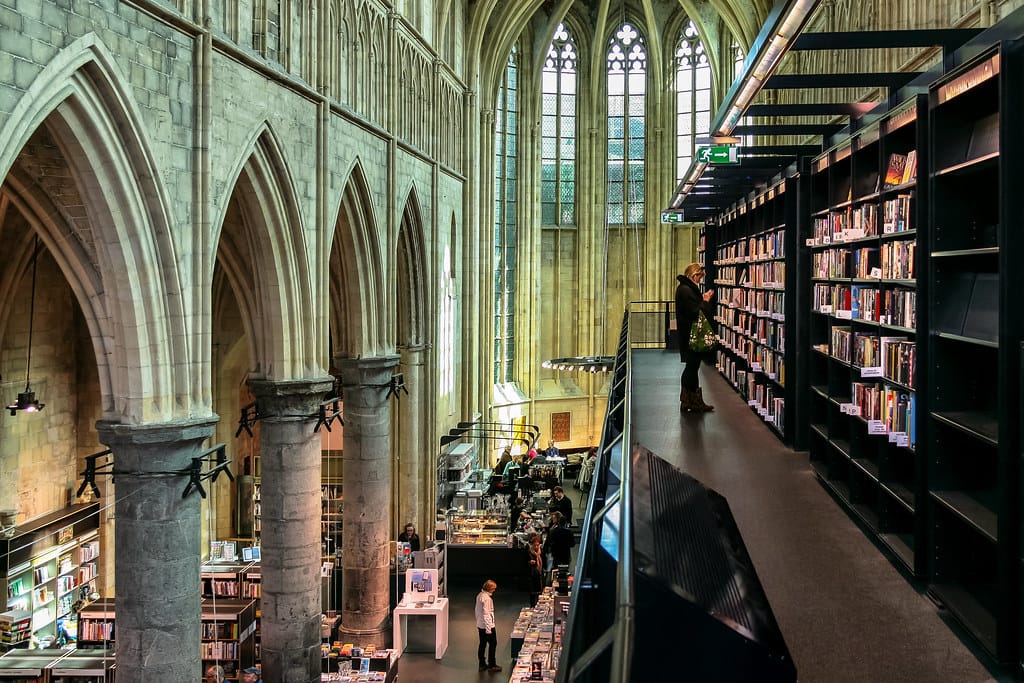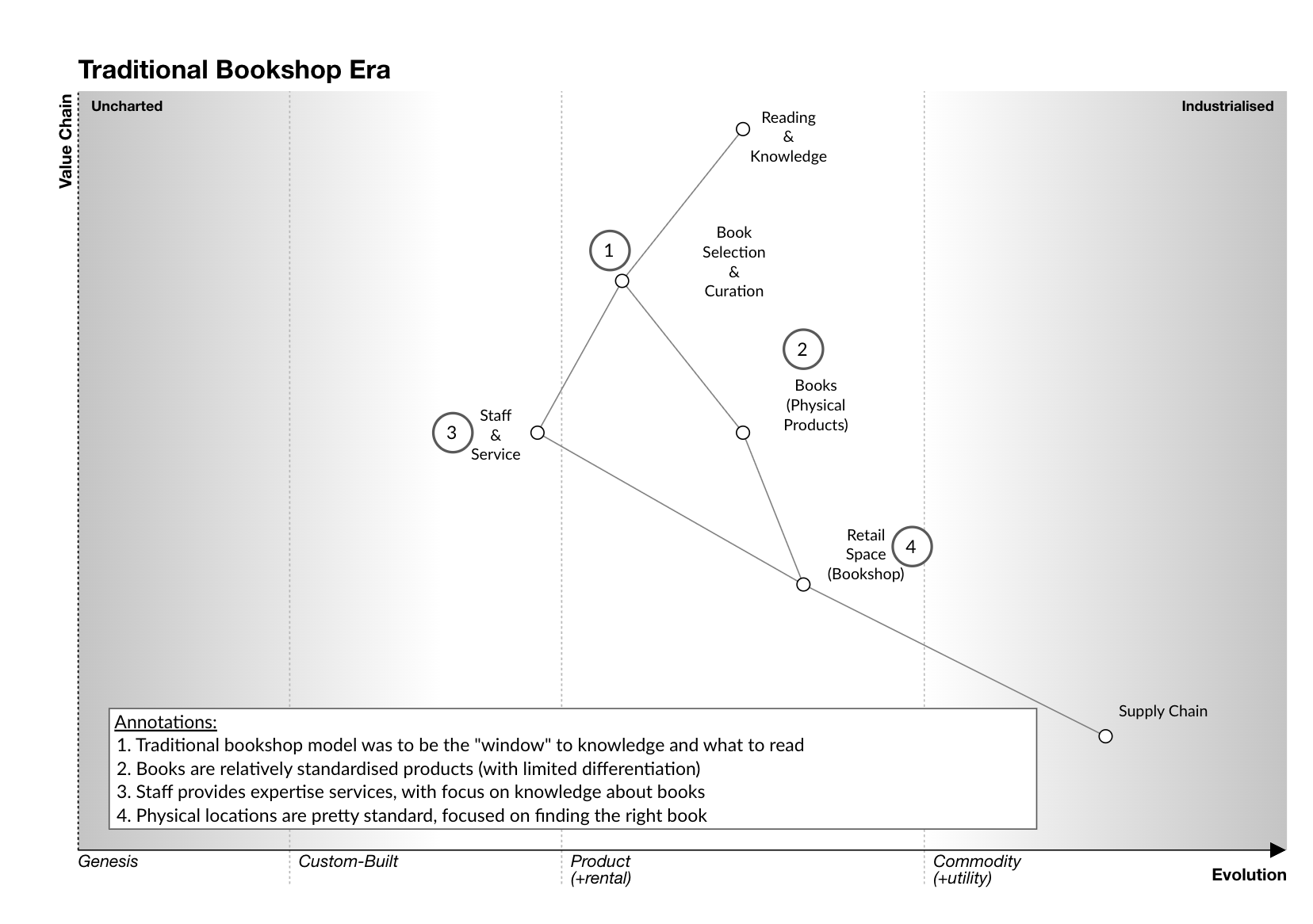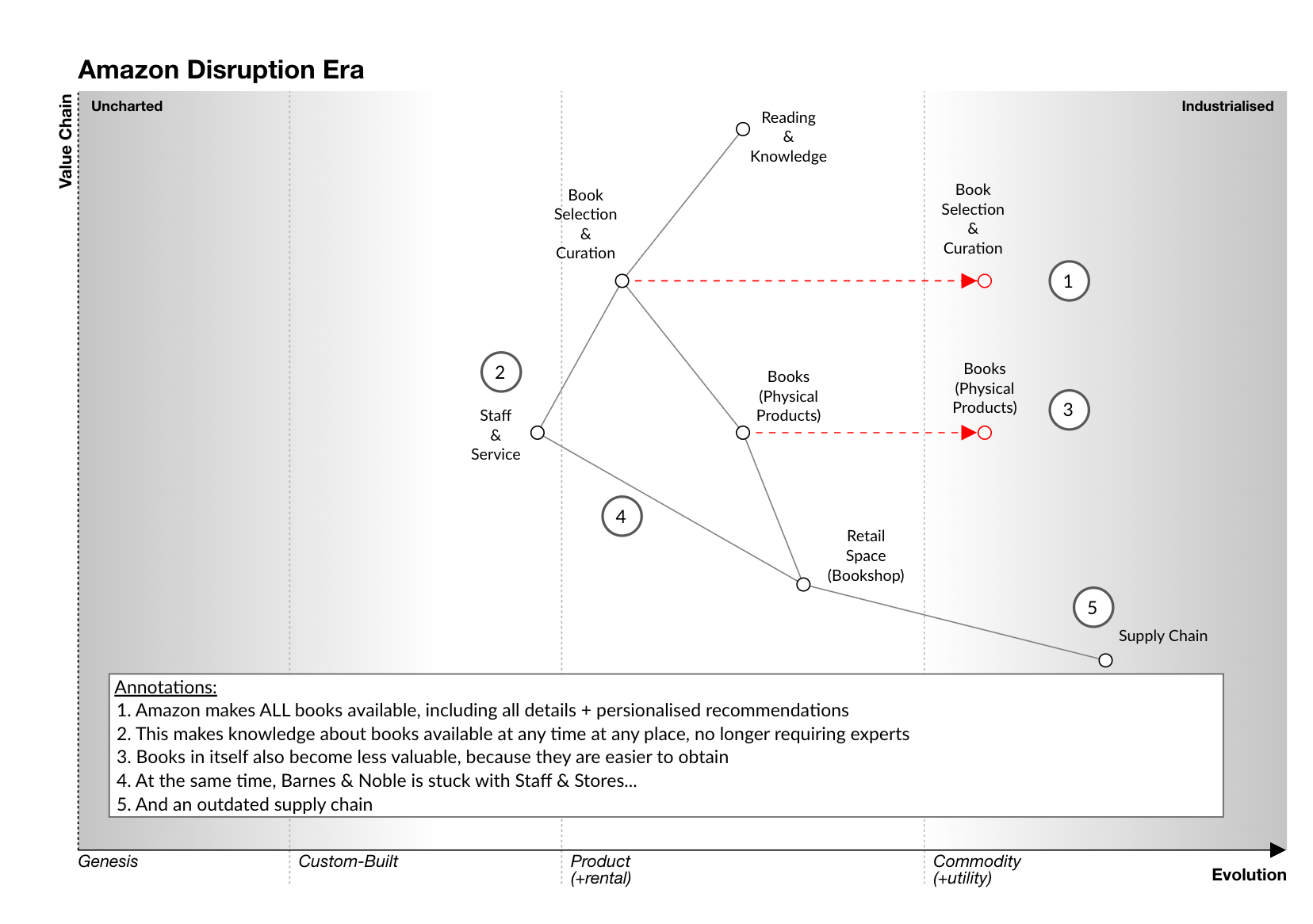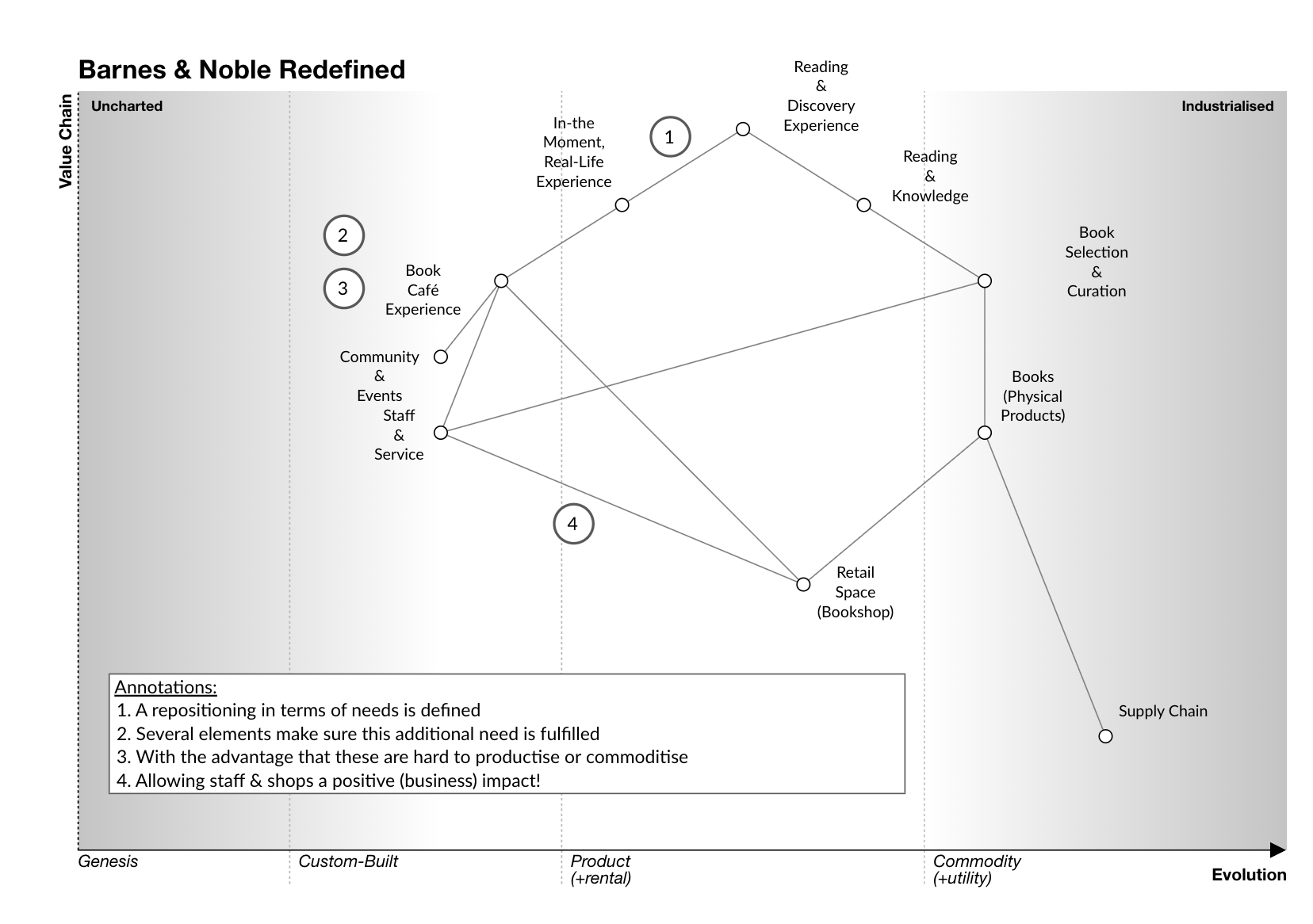What To Do When Your Core Activity Becomes Commodity (Almost) Overnight?
A LinkedIn update about Barnes & Noble not only made me happy, it also is the perfect case to illustrate the value of Wardley Mapping for strategic thinking!

TWIL episode 14 - August 2025
I love buying books—and reading them too ;)
I often buy online, but there's something special about browsing physical bookshops. The smell of paper takes you to different worlds - it gets even better when the shop combines the books with a great experience 📚
So when I read a LinkedIn post about Barnes & Noble's surviving the disruption from Amazon (and the internet in general) I was really happy. And I also recognised how my own interaction with bookstores has changed.
But more than how and where I spend my book budget, it reminded me how important it is as a company to deal with changing context and find your way back to value creation. The Barnes & Noble story isn't just about books—it's also an interesting case to practice strategic thinking. Skills every (aspiring) leader should master.
It becomes even more interesting if you look at this case through today's lens: a pivotal moment in the knowledge working and creative industry we (almost) all work in. As GenAI is making a lot of our work way more accessible to a lot more people, it is clear that commoditisation is a force not only impacting bookstores, but all of us.
In this newsletter, I'll introduce you to Wardley Mapping, a tool that helps you see your competitive landscape and spot opportunities for change. Through the Barnes & Noble case, we'll explore how understanding your value chain evolution can show new paths forward when competitors push your core activities towards commodity status. So you can use this as inspiration for you own value chain.
The Commoditisation Problem: When Your Core Business Becomes Everyone's Game 🎯
Let's start with a basic observation about business evolution: everything that can become a commodity, eventually will. It's not a question of if, but when.
Amazon didn't just sell books online—they challenged the entire book retail industry by automating the job of the bookstores, making it possible to buy a super large range of books 24/7.
This changed the rules of the game. All of the sudden, the physical bookstores and the expertise of the personnel got a very accessible alternative. Moreover the massive inventory with all info about the books, combined with personalised recommendations made it possible to buy on other criteria:
- Price comparison
- Delivery speed
- Stock availability
- Simple ordering process
The name of the game? Commodity business.
When Your Core Business Faces Commoditisation, You Have Two Choices
Option 1: Fight the commoditisation head-on
- Cut costs wherever possible
- Improve operational efficiency
- Try to compete on the same terms as your disruptors
This more often than not leads to failure: you're playing their game, but you have your legacy (in terms of organisation, culture, people, cost structure, supplier contracts, ...) working against you.
Option 2: Step back and rethink your approach
The alternative is to take a step back and:
- Map your landscape properly
- Find new ways to create value
- Move beyond the commodity game entirely
This approach requires courage but - if successful - offers better long-term prospects.
Enter Wardley Mapping: Your Strategic Navigation System 🗺️
Wardley Mapping, developed by Simon Wardley, is like having a GPS for strategic decisions. It helps you see your business landscape, understand how different parts evolve over time, and spot opportunities that aren't immediately obvious.
A Wardley Map has two main elements:
Value Chain (vertical axis): The top has the user needs, which are fulfilled with supporting components, which may need subcomponents. The higher up in the value chain, the more visible these components are for the users, with basic infrastructure at the bottom.
Evolution (horizontal axis): One of the base ideas is that each component goes through a lifecycle. Starting as a fresh, experimental idea in the genesis phases. At some point, certain components will evolve to custom-built, bespoke solutions. If successful enough, standardised offerings will appear as products. Which in turns will become commodity under pressure of competition.
The value comes when you map out your current position. This allows you to understand the evolutionary forces working on you, so you can choose which game you want to play, where you want to play and which behaviour you need to win this game.
Those who read my previous issue may recognise the overlap with the 5 strategic choices 😀
Mapping the Bookstore Transformation 📊
Let me make this concrete through the Barnes & Noble story, using three strategic maps.
Map 1: The Traditional Bookshop Era - Being the "Window" to Knowledge 🏪
In the pre-Amazon world, bookstores were the "window": They linked readers to books & knowledge.
The setup was straightforward:

As you see on the map, reading & knowledge was the core user need. The different elements of the value chain were aligned to fulfilling that need, with staff mainly as the people helping you to find the book(s) you were looking for.
This model worked because there weren't many alternatives. People had to go to the bookshops: the physical bookshops were the (only) way to deliver the physical item a book is. So bookshops controlled access to both the products and the knowledge about what to read.
Map 2: The Amazon Disruption - Commoditising Curation ⚡
When Amazon entered the market, they fundamentally changed the game.

Here's what shifted:
- Amazon made (almost) ALL books available, including complete details, reviews and personalised recommendations
- Knowledge about books became available anytime, anywhere - no longer requiring experts and not limited by opening (or better, closing) hours
- Even books themselves became less valuable because they were easier to obtain (especially when also the eBooks became available)
At the same time, the classical bookshops like Barnes & Noble got stuck with legacy infrastructure that became disadvantages: staff costs for expertise that Amazon automated in algorithms, physical stores with closing hours, outdated supply chain processes...
The evolution arrows on this map show the critical shift:
- Book Selection & Curation evolving towards commodity (Amazon's algorithms)
- Books (Physical Products) commoditised along the way, especially since the introduction of eBooks
This is the classic disruption pattern: the disruptor takes a profitable part of the value chain and pushes it to the right on the evolution axis, operating with a fundamentally different approach, optimised for the new evolutionary state. In the meantime, incumbents have a hard time adapting, as they face internal inertia and carry legacy costs.
Map 3: The Strategic Reinvention - From Knowledge to Experience 🔄
Instead of continuing to fight Amazon on their terms, Barnes & Noble is taking a different path. They took a step back and figured out they could reposition themselves in relation to a redefined set of user needs.
The key insight: Combine the (commoditised) need "reading & knowledge" with an "in-the-moment, real-life experience" that cannot be reproduced online.

This allowed them to repurpose their existing assets:
- Staff & Service became experience facilitators rather than just book experts
- Retail Spaces transformed from product displays to community hubs
- Physical presence became an advantage for creating authentic connections
The Strategic Lessons: Beyond Books 💡
The Barnes & Noble transformation shows several important insights about strategic positioning and how Wardley Mapping can help in understanding the landscape you are in.
1// Return to User Needs 🎯
When your current offering becomes commoditised, go back to the fundamental user needs you're serving. Barnes & Noble realised their users didn't just want books—they also wanted: spend time in the coziness of coffee and books, discover atypical titles and ideas, connect with fellow readers, and who knows... smell the paper 😜
2// Move Up the Value Chain ⬆️
Rather than competing on the commoditised layer, find ways to add value at higher levels: from selling books (functional job) to creating reading & discovery experiences (emotional job).
3// Localisation Over Standardisation 🌍
Find areas that you can serve in the "custom" stage of evolution and do some experiments in the "genesis" stage. In this case by making each bookshop unique and adapted to the location, making them harder to copy.
4// Use your Constraints as Advantages 💪
Instead of seeing staff & physical stores as expensive burdens, Barnes & Noble imagined new relations between these existing assets and new parts in the value stream. They repurposed their main assets to create the physical place needed for the new book experience.
5// Evolution Never Stops 🔄
The maps show that evolution arrows keep moving. What's custom today becomes product tomorrow, and product becomes commodity the day after. Keep on the lookout and anticipate these changes and position yourself accordingly.
The Broader Implications 🚀
This example shows why Wardley Mapping is useful for product strategists and business leaders, but also for us as knowledge workers. Indeed, it helps you:
Anticipate Evolution 🔮
- Understand where your components are on the evolution axis
- Predict future commoditisation trends
- Prepare for changes before competitors force your hand
- Spot opportunities as components evolve
Identify White Spaces 🕳️
- Mapping reveals gaps in the value chain where new value can be created
- Shows where user needs are evolving beyond current offerings
- Highlights areas where competitors haven't yet focused
- Points to adjacent opportunities you might not have considered
Make Strategic Decisions 🎯
- Visualise your competitive landscape clearly
- Understand evolutionary forces and their timing
- See dependencies between different parts of your business
- Make strategic choices with better information about the whole system
Focus Resources 💰
- Stop spreading efforts across all areas
- Identify where to double down for maximum impact
- Decide what to let go of or commoditise
- Invest in areas where you can create distinctive value
Applying Wardley Mapping to Your Context 🔧
The power of Wardley Mapping isn't just in creating pretty diagrams. It's in forcing you to think systematically about your competitive landscape, understand the forces of change, and position yourself where you can create the most distinctive value.
With AI commoditising a lot of knowledge work, this question has become very relevant (whether we like it or not) to myself AND a lot of readers of this newsletter.
Which needs are you solving? And what does it mean when AI is pushing elements of you personal value chain to the right?
I wish you a lot of fun mapping out your own future! (and fun reading 📖 😄)
P.S.: For those book lovers in Belgium, I can definitely suggest the even smaller bookstores who do a great job in giving you the a great book experience! https://www.facebook.com/LimerickGent/ (books + coffee) https://cookandbook.com/ (books + food) or https://www.boekhandeldominicanen.nl/ (just across the NL border, books in a cathedral - see also the cover image of the newsletter episode)
Further Reading and References 📚
- Simon Wardley's comprehensive series on Wardley Mapping: https://medium.com/wardleymaps/on-being-lost-2ef5f05eb1ec
- The original LinkedIn post about Barnes & Noble's transformation: https://www.linkedin.com/feed/update/urn:li:share:7353116012759695360/
